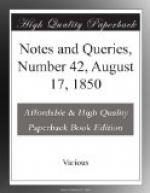“Some report that they have found great benefit in the conservation of their health by wearing scarlet waistcoats next their skin and under their shirts, as well down to their nether parts as on the upper.”
From the quantity of serge bought, as well as from the nature of the material, I think it likely it might be required for the purpose here noticed by Bacon, and not for an outer waistcoat.
ARUN.
The Curfew (Vol. ii., p. 103.).—As NABOC can, I imagine, only get a perfect list of the places where the curfew is still rung by the contributions of scattered correspondents, I will furnish my mite by informing him that a very short time ago it was rung at Sturminster Newton in Dorsetshire.
J. BT.
Welsh Language; Armenian Language (Vol. ii., p. 136.).—JARLTZBERG will find no Welsh dictionary with the part reversed. I possess a dictionary in Welsh and English, in two volumes, by Pugh, published in 1832, which is one of the best. The one in two volumes by Walters is in English and Welsh, and is also one of the best. The four volumes would make a good dictionary. The best grammar is, I think, Pugh’s. See the Welsh bookseller in Holywell Street: I believe his name is Williams.
Father Chamick compiled the History of Armenia from the historical works of several authors, which was published at Venice in 1786; and in 1811 an abridgment thereof, which was translated by Mr. Acdall, of Calcutta, in 1827. See Messrs. Allen and Co.’s Catalogue of Oriental Works, at whose house these, and translations of other works (particularly the History of Vartan and the Memoirs of Artemi), may be procured. I think JARLTZBERG will find a dictionary in Armenian and French. I saw a notice of one a short time since. (See Bernard Quaritch.) In 1841, Peterman published at Berlin, Porta Ling. Orient., sive Elementa Ling. Syr., Chald., Arab., &c. &c., which I think contains an Armenian grammar. See Williams and Norgate; also a list of Klaproth’s works.
AREDJID KOOEZ.
Armenian Language (Vol. ii., p. 136.).—In reply to JARLTZBERG, I can answer that Lord Byron did not compose the English part of Aucher’s Armenian and English Grammar. A very learned friend of mine was at St. Lazero, in Venice, and knew both Aucher and Lord Byron. Lord Byron was taking lessons in Armenian, and a few of his exercises were introduced into Aucher’s Grammar, which was written for Armenians to learn English, with which language Aucher was quite familiar, having resided four years in London. But a new Armenian and English Grammar has recently been published. There is one, very rare, in Armenian and Latin, and another in Armenian, modern Greek, and Italian. I have just seen John Bunyan’s Pilgrim’s Progress in vulgar Armenian, with plates, published at Smyrna; and the Prayers of St. Nierses, in twenty-four languages, Venice, 1837, of which Armenian is one. Several works in Armenian have been published at Calcutta.




